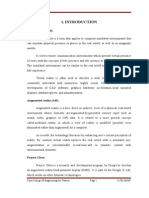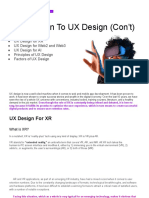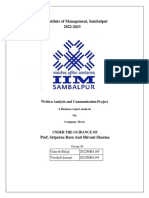Google Glass Seminar Report: Recommended
Google Glass Seminar Report: Recommended
Uploaded by
rohitCopyright:
Available Formats
Google Glass Seminar Report: Recommended
Google Glass Seminar Report: Recommended
Uploaded by
rohitOriginal Title
Copyright
Available Formats
Share this document
Did you find this document useful?
Is this content inappropriate?
Copyright:
Available Formats
Google Glass Seminar Report: Recommended
Google Glass Seminar Report: Recommended
Uploaded by
rohitCopyright:
Available Formats
HOME TOPICS CONTACT UPLOAD LOGIN / REGISTER
Home / Topics / Documents / Google Glass Seminar Report
Recommended
No recommend documents
1 of 17
Google Glass Seminar Report
Published on May 2016 | Categories: Documents | Downloads: 320 | Comments: 0
Lalith Manoj
Subscribe 0 784 views
Like 0 Share Tweet Share Save 0 Download Embed Report
Comments
0 Comments Sort by Oldest
Add a comment...
Facebook Comments Plugin
Content
GOOGLE GLASS
Contents
Introduction Technologies Used Design Working Advantages Future Scope Conclusion Reference
ABSTRACT
Project Glass is a research and development program by Google to develop an augmented reality Head-Mounted Display (HMD). The intended
purpose of Project Glass products would be the hands-free displaying of information currently available to most smartphone users, and allowing for
interaction with the Internet via natural language voice commands. These glasses will have the combined features of virtual reality and augmented
reality. Google glasses are basically wearable computers that will use the same Android software that powers Android smartphones and tablets.
Google Glass is as futuristic a gadget we’ve seen in recent times. A useful technology for all kinds of people including handicapped/disabled.
Introduction
About google
Google Inc. is an American multinational corporation specializing in Internet-related services and products. These include search, cloud computing,
software and online advertising technologies. Google began in January 1996 as a research project by Larry Page and Sergey Brin. It was originally
a search engine who ranks the websites(PageRank) and return them as search results according to user query, with time Google grew and
presently it provides many other features than only search results i.e. it now provides image search, YouTube(largest collection of online videos)
and many more. It has its own R & D department know as “Google X”, where the project “Google Glass” was made. Google glass uses virtual and
augmented reality to interact with user.
Virtual reality (VR):
Virtual reality is a term that applies to computer-simulated environments that can Simulate physical presence in places in the real world, as well as
in imaginary worlds.It covers remote communication environments which provide virtual presence of users with the concepts of telepresence and
telexistence or a virtual artifact (VA). The simulated environment can be similar to the real world in order to create a life like.
Augmented reality (AR):
Augmented reality is a live, direct or indirect, view of a physical, real-world environment whose elements are augmented by generated sensory
input such as sound, video, graphics or GPS data. It is related to a more general concept called mediated reality, in which a view of reality is
modified (possibly even diminished rather than augmented) by a computer. As a result, the technology functions by enhancing one’s current
perception of reality.By contrast, virtualreality replaces the real world with a simulated one. Augmentation is conventionally in real-time and in
semantic context with environmental elements.
Project Glass:
Project Glass is a research and development program by Google to develop an augmented reality head-mounted display (HMD). It is part of the
Google X Lab, which works on other futuristic technologies. The intended purpose of Project Glass products would be the hands-free displaying of
information currently available to most smartphone users, and allowing for interaction with the Internet via natural language voice commands. The
functionality and physical appearance (minimalist design of the aluminum strip with 2 nose pads) has been compared to SteveMann's EyeTap,
which was also referred to as "Glass" ("EyeTap Digital Eye Glass", i.e. uses of the word "Glass" in singular rather than plural form "Glasses").
Technologies used:
WearableComputig:
Wearable computers, also known as body-borne computers are miniature electronic devices that are worn by the bearer under, with or on top of
clothing.This class of wearable technology has been developed for general or special purpose information technologies and media development.
Wearable computers are especially useful for applications that require more complex computational support than just hardware coded logics.
One of the main features of a wearable computer is consistency.There is a constant interaction between the computer and user, i.e.there is no need
to turn the device on or off. Another feature is the ability to multi-task. It is not necessary to stop what you are doing to use the device; it is
augmented into all other actions. These devices can be incorporated by the user to act like a prosthetic. It can therefore be an extension of the
user’s mind and/or body.
Ambient Intelligence:
Ambient Intelligence (AmI) refers to electronic environments that are sensitive and responsive to the presence of people.Ambient intelligence is a
vision on the future of consumer electronics, telecommunications and computing.
In an ambient intelligence world, devices work in concert to support people in carrying out their everyday life activities, tasks and rituals in easy,
natural way using information and intelligence that is hidden in the network connecting these devices. As these devices grow smaller, more
connected and more integrated into
our environment,the technology disappears into our surroundings until only the user interface remains perceivable by users.
Smart Clothing:
Smart clothing is the next generation of apparel. It is a combination of new fabric technology and digital technology, which means that the clothing
is made with new signal-transfer fabric technology installed with digital devices. Since this smart clothing is still under development, many problems
have occurred due to the absence of the standardization of technology. Therefore, the efficiency of technology development can be strengthened
through industrial standardization. This study consists of three phases. The first phase is selecting standardization factors to propose a
standardization road map. The second phase is to research and collect related test evaluation methods of smart clothing. For this, we selected two
categories, which are clothing and electricity/electron properties.
The third phase is establishing a standardization road map for smart clothing. In this study, test evaluations have not yet been conducted and
proved. However, this study shows how to approach standardization. We expect that it will be valuable for developing smart clothing technology
and standardization in the future.
EyeTapTechnology:
An EyeTap is a device that is worn in front of the eye that acts as a camera to record the scene available to the eye as well as a display to
superimpose a computer-generated imagery on the original scene available to the eye. This structure allows the user's eye to operate as both a
monitor and a camera as the EyeTap intakes the world around it and augments the image the user sees allowing it to overlay computer-generated
data over top of the normal world the user would perceive. The EyeTap is a hard technology to categorize under the three main headers for
wearable computing (Constancy, Augmentation, and Mediation) for while it is in theory a constancy technology in nature it also has the ability to
augment and mediate the reality the user perceives.
Smart Grid Technology:
A smart grid is an electrical grid that uses information and communications technology togather and act on information, such as information about
the behaviors of suppliers and consumers, in an automated fashion to improve the efficiency, reliability, economics, and sustainnability of the
production and distribution of electricity.
AndroidOperating System:
Android is a Linux-based operating system for mobile devices such as smart phones and tablet computers, developed by Google in conjunction
with the Open Handset Alliance. Android is open source and Google releases the code under the Apache License.This open source code and
permissive licensing allows the software to be freely modified and distributed by device manufacturers, wireless carriers and enthusiast developers.
Additionally, Android has a large community of developers writing applications ("apps") that extend the functionality of devices, written primarily in a
customized version of the Java programming language. In October 2012, there were approximately 700,000 apps available for Android, and the
estimated number of applications downloaded from Google Play, Android's primary app store, was 25 billion.
Its features with the small video display that is used to display the pop up hands free information.
Camera:
It also has the front facing video camera with which photos and videos can be taken in a glimpse.
Speaker:
Google glasses are designed to be hands free wearable device that can be used to make or receive calls too. So a speaker is also designed by the
ear.
Button:
A single button on the side of the frame sophisticates the glasses to work with the physical touch input.
Microphone:
A microphone is also put in, that can take the voice commands of the wearer of user. This microphone is also used for having telephonic
communication.
Working:
THE OVERALL DESIGN OF GOOGLE GLASSES
The device will probably communicate with mobile phones through Wi-Fi and display contents on the video screen as well as respond to the voice
commands of the user. Google put together a short video demonstrating the features and apps of Google glasses. It mainly concentrates on the
social networking, navigation and communication.
The video camera senses the environment and recognizes the objects and people around. The whole working of the Google glasses depends upon
the user voice commands itself.
Overall Working
THE OVERALL WORKING OF GOOGLE GLASSES
Advantages and Disadvantages
Advantages :
Easy to wear and use. Sensitive and responsive to the presence of people. Fast access of maps, documents, videos, chats and much more. A new
trend for fashion lovers together being an innovative technology. A spectacle based computer to reside directly on your eyes rather than in your
pouch or pocket. A useful technology for all kinds of handicapped/disabled people.
Disadvantages:
Can be easily broken or damaged. Though Google wants these glasses to be as modest as achievable, they seem to be extremely breakable.
Users will have a tough time taking care of it. These glasses show the retrieved data in front of users eyes so it will be a tough experience for them
since they will focus on that data and will eventually miss the surroundings that may lead to accidents while driving. The resource for running these
glasses is still unknown. Will there be a battery or it will run using solar energy? Privacy of people may breach with new glasses.
Future Scope
Google Glass is as futuristic a gadget we’ve seen in recent times. It’s limited in scope right now, but the future, Google believes, is bright and the
device itself is “incredibly compelling”. Google is trying their hardest to push the Project Glass through the FCC this year. Reports show that Google
is trying to get the approval by the FCC this year but there are already several hundred glasses made for testing internally.
CONCLUSION
Google glasses are basically wearable computers that use the evolving familiar technologies that brings the sophistication and ease of
communication and information access even for the physically challenged class of people those literallycould not use general way of palmtops and
mobiles.
Reference
http://en.wikipedia.org/wiki/Project_Glass http://www.smart-glasses.org/benefits-smart-glasses/ http://en.wikipedia.org/wiki/EyeTap
http://www.techpark.net/2012/02/29/google-glasses-with-virtual-andaugmentedreality/ http://dl.acm.org/citation.cfm?id=1601355
http://en.wikipedia.org/wiki/Android_(operating_system) http://www.webmd.boots.com/eye-health/news/20120411/will-googleglasses-be-safe
http://www.thenewstribe.com/2012/04/08/google-project-glasses-successor-anotherfailure/#.UFMcL7LiaAA http://www.redmondpie.com/google-
project-glass-gets-an-awesomeskydiving-demoat-io-explorer-edition-up-for-pre-order-video/
Sponsor Documents
USEFUL LINKS GET UPDATES SOCIAL NETWORK
About Us Privacy Policy
Enter email
Share what you know and love through
Terms of Service Help
presentations, infographics, documents and
more Copyright Contact Us Subscribe to our newsletter and stay up to
date with the latest updates and documents!
2015 - 2017 © All Rights Reserved.
You might also like
- Inclusive Adaptive Clothing: Business Model CanvasDocument33 pagesInclusive Adaptive Clothing: Business Model CanvasGladwin Joseph100% (3)
- Google Glass: A Project ReportDocument14 pagesGoogle Glass: A Project ReportankitaNo ratings yet
- Krishna Google Glass ReportDocument14 pagesKrishna Google Glass ReportKrishna SinghNo ratings yet
- Google Glass: A Seminar Report OnDocument12 pagesGoogle Glass: A Seminar Report OnjoeNo ratings yet
- Google Glasses: SKBR - Pg.College AmalapuramDocument6 pagesGoogle Glasses: SKBR - Pg.College AmalapuramAnonymous Zg6BlT3No ratings yet
- Google Glass Seminar ReportDocument26 pagesGoogle Glass Seminar ReportNiladri Paul100% (1)
- Term Paper About Google GlassDocument6 pagesTerm Paper About Google GlassOnlinePaperWriterSingapore100% (1)
- Google Glass Usedas AssistivDocument14 pagesGoogle Glass Usedas AssistivGet InspiredNo ratings yet
- A Review On Google Glass and Its Technologies: C.Durga K.Swathi A.Ramadevi M.NarmadaDocument8 pagesA Review On Google Glass and Its Technologies: C.Durga K.Swathi A.Ramadevi M.NarmadaEditor InsideJournalsNo ratings yet
- Abstract:: Project Glass Is A Research and Development Program by Google To Develop An AugmentedDocument8 pagesAbstract:: Project Glass Is A Research and Development Program by Google To Develop An AugmentedHari Krishna RoyNo ratings yet
- Under The Guidance ofDocument9 pagesUnder The Guidance ofKaran BossNo ratings yet
- Google Glass Thesis StatementDocument4 pagesGoogle Glass Thesis StatementWriteMyBusinessPaperUK100% (2)
- Google-Glass-Seminar-Report MODIFIED by LOHITHDocument27 pagesGoogle-Glass-Seminar-Report MODIFIED by LOHITHlohith jvsNo ratings yet
- Google GlassDocument22 pagesGoogle GlassAbhinav ArakkanNo ratings yet
- Group 5 Presentation Chapter 1 ADETDocument57 pagesGroup 5 Presentation Chapter 1 ADETRaiza AnancaNo ratings yet
- Literature Review On Google GlassDocument4 pagesLiterature Review On Google Glassc5qj4swh100% (1)
- Google Glass Paper Presentation - PROJECT GLASS ODPDocument32 pagesGoogle Glass Paper Presentation - PROJECT GLASS ODPGowtham RajNo ratings yet
- Google Glass PPT 1Document22 pagesGoogle Glass PPT 1Ankit KumarNo ratings yet
- New Advances For Output DevicesDocument5 pagesNew Advances For Output DevicesLisaNo ratings yet
- Google Glass Seminar ReportDocument30 pagesGoogle Glass Seminar ReportVishalSahNo ratings yet
- Google Glass Seminar ReportDocument41 pagesGoogle Glass Seminar ReportmlwececehodNo ratings yet
- Google Glass EditedDocument26 pagesGoogle Glass EditedAnirudh MaheshwaramNo ratings yet
- Advance Technology-Google Glass: Pooja S. MankarDocument5 pagesAdvance Technology-Google Glass: Pooja S. Mankarsohail khanNo ratings yet
- Googleglass HARI VALLABH - 1Document28 pagesGoogleglass HARI VALLABH - 1Saloni SharmaNo ratings yet
- Google GlassDocument17 pagesGoogle GlassNagarajuNeeliNo ratings yet
- V2i3 0118 PDFDocument4 pagesV2i3 0118 PDFAmrutanarkhedeNo ratings yet
- Institute of Engineering & Technology, Alwar: Seminar On: "Google Glasses "Document21 pagesInstitute of Engineering & Technology, Alwar: Seminar On: "Google Glasses "mahendra goyalNo ratings yet
- Google GlassDocument22 pagesGoogle GlassAjay Narahari0% (1)
- Android ProjectDocument70 pagesAndroid Projectshweta dubeyNo ratings yet
- GoogleDocument30 pagesGoogleGaurav KumarNo ratings yet
- Week 5Document8 pagesWeek 5John Denver De la CruzNo ratings yet
- Lpu Internship PresentationDocument29 pagesLpu Internship Presentationnani rulzzNo ratings yet
- Google Play Store Apps-Data Analysis and Ratings PredictionDocument10 pagesGoogle Play Store Apps-Data Analysis and Ratings PredictionAnubhav NathNo ratings yet
- PCS - Google GlassDocument11 pagesPCS - Google GlassAbdul ArifNo ratings yet
- Cloud Computing in Google GlassDocument2 pagesCloud Computing in Google GlassseventhsensegroupNo ratings yet
- Abstract: Augmented Reality (AR) : Project Glass Is A Research andDocument6 pagesAbstract: Augmented Reality (AR) : Project Glass Is A Research andvineetpaladi100% (2)
- Project Proposal: Team SasDocument29 pagesProject Proposal: Team SasSanchit MallickNo ratings yet
- Google Glasses: by Sai Charan Reddy Mutyala 12N61A0536Document23 pagesGoogle Glasses: by Sai Charan Reddy Mutyala 12N61A0536Charan Reddy MutyalaNo ratings yet
- Google Glass: DocumentationDocument22 pagesGoogle Glass: DocumentationAnirban DuttaNo ratings yet
- Google Glasses PDFDocument17 pagesGoogle Glasses PDFVipul KrNo ratings yet
- Google Glass-Seminar ReportDocument23 pagesGoogle Glass-Seminar ReportAnanthuSibyNo ratings yet
- PRESENTATION: From Internet Usage To Genomics Analysis With Google BigQueryDocument70 pagesPRESENTATION: From Internet Usage To Genomics Analysis With Google BigQueryADB Health Sector GroupNo ratings yet
- Business Case - EarBudDocument23 pagesBusiness Case - EarBudvan.vn0912No ratings yet
- Virtual Reality (VR) :: Google GlassesDocument21 pagesVirtual Reality (VR) :: Google GlassesSteven BrownNo ratings yet
- final new product developmentDocument15 pagesfinal new product developmentashcrutchfield15No ratings yet
- Eyedeus Business Plan (Plan9)Document14 pagesEyedeus Business Plan (Plan9)Mubarak SaleemNo ratings yet
- AI Invasion 2021Document132 pagesAI Invasion 2021Jimmy HawkinsNo ratings yet
- Current and Future Trends in Media and InformationDocument49 pagesCurrent and Future Trends in Media and Informationbryl john lawrence villamarNo ratings yet
- Google Glass Term PaperDocument8 pagesGoogle Glass Term Paperc5s8r1zc100% (1)
- A Technical Seminar On: Ms. Soni Mishra P. Venu Regd. No. 12845A0416 Ms. Juweria BegumDocument25 pagesA Technical Seminar On: Ms. Soni Mishra P. Venu Regd. No. 12845A0416 Ms. Juweria BegumTalib GaznayNo ratings yet
- Synopsis - Note Sharing Application Using DjangoDocument12 pagesSynopsis - Note Sharing Application Using Djangonaina nautiyalNo ratings yet
- Milestone 01Document11 pagesMilestone 01free2ride19No ratings yet
- Design For SensorDocument33 pagesDesign For SensorsauviragccNo ratings yet
- Sample For Internship ReportDocument230 pagesSample For Internship ReportSuveesh PanickarNo ratings yet
- Class Note Introduction To UX Design 2Document19 pagesClass Note Introduction To UX Design 2Wasiu TiamiyuNo ratings yet
- Inbound 3216076994237878038Document55 pagesInbound 3216076994237878038ivancasuga10No ratings yet
- Practical No. 2: Use Google Docs To Make Spreadsheets and Notes. Google Document For JournalDocument13 pagesPractical No. 2: Use Google Docs To Make Spreadsheets and Notes. Google Document For JournalG2018 Choudhari NikitaNo ratings yet
- Innovation Equity: Assessing and Managing the Monetary Value of New Products and ServicesFrom EverandInnovation Equity: Assessing and Managing the Monetary Value of New Products and ServicesNo ratings yet
- Mastering Android Wear Application Development: Master the Android Wear SDK and APIs to build cutting edge wearable appsFrom EverandMastering Android Wear Application Development: Master the Android Wear SDK and APIs to build cutting edge wearable appsNo ratings yet
- Machine Learning for Developers: Uplift your regular applications with the power of statistics, analytics, and machine learningFrom EverandMachine Learning for Developers: Uplift your regular applications with the power of statistics, analytics, and machine learningNo ratings yet
- IT - Grade-12 - Term-1 - Final Exam Paper - Version-A - 2021-2022Document6 pagesIT - Grade-12 - Term-1 - Final Exam Paper - Version-A - 2021-2022ahmadNo ratings yet
- Transforming Women Safety With Information TechnolDocument11 pagesTransforming Women Safety With Information Technolabiramig1602No ratings yet
- A Machine Learning Based WSN System For Autism Activity RecognitionDocument10 pagesA Machine Learning Based WSN System For Autism Activity Recognitionnabeel hasanNo ratings yet
- WelcomeDocument18 pagesWelcomevidyadhreevidyashreeNo ratings yet
- A1 Paper4 TangDocument22 pagesA1 Paper4 Tangkelly2999123No ratings yet
- REPORT - BLUEPRINT - GROUP 4 - CS2496A2 - MedTech by Robot NursAIDocument47 pagesREPORT - BLUEPRINT - GROUP 4 - CS2496A2 - MedTech by Robot NursAI2021826386No ratings yet
- Indian Institute of Management, Sambalpur 2022-2023: Written Analysis and Communication ProjectDocument15 pagesIndian Institute of Management, Sambalpur 2022-2023: Written Analysis and Communication ProjectGANESH BALAJI.N 1715111100% (1)
- Current-And-Future-Trends Mil 12Document41 pagesCurrent-And-Future-Trends Mil 12Claire Magalona100% (1)
- Macquarie University IOL - IELTS Academic Reading - Practice Test 2 - QuestionsDocument13 pagesMacquarie University IOL - IELTS Academic Reading - Practice Test 2 - QuestionsTrí NghiênNo ratings yet
- Mil 2ND Quarter ReviewerDocument15 pagesMil 2ND Quarter ReviewerMark Abraham GarciaNo ratings yet
- Healthcare 4.0 FrontiersDocument23 pagesHealthcare 4.0 FrontiersiV32No ratings yet
- Wearable Smart Technologies: New Era of TechnologyDocument65 pagesWearable Smart Technologies: New Era of TechnologyAlam CarrascoNo ratings yet
- Massive Open Online ContentDocument20 pagesMassive Open Online ContentMa Blesilda Michaela SarbuesNo ratings yet
- wt6000 rs6000 Accessories GuideDocument14 pageswt6000 rs6000 Accessories GuideToma HrgNo ratings yet
- Top Mobile App Development Trends For 2021Document23 pagesTop Mobile App Development Trends For 2021Janhavi AhirwarNo ratings yet
- UntitledDocument14 pagesUntitledAitana Castro BravoNo ratings yet
- Ideas For Topics of Formal Writing OxfordDocument90 pagesIdeas For Topics of Formal Writing Oxfordadam.elsayed208No ratings yet
- Nasal strip Full Market ResearchDocument25 pagesNasal strip Full Market Researchyounes.bensgiriNo ratings yet
- Current and Future Trends in Social MediaDocument38 pagesCurrent and Future Trends in Social MediaROMMEL III ARGUELLESNo ratings yet
- Insurance Reinvented: Value-Added ServicesDocument20 pagesInsurance Reinvented: Value-Added ServicesHugo Cavassa CasalinoNo ratings yet
- Research Article Fog Computing Service in The Healthcare Monitoring System For Managing The Real-Time NotificationDocument11 pagesResearch Article Fog Computing Service in The Healthcare Monitoring System For Managing The Real-Time Notificationpatil.maNo ratings yet
- Design and Development of Low Investment Smart Hospital Using Internet of Things Through Innovative ApproachesDocument7 pagesDesign and Development of Low Investment Smart Hospital Using Internet of Things Through Innovative ApproachesBhind Raj PandeyNo ratings yet
- Abstract: Augmented Reality (AR) : Project Glass Is A Research andDocument6 pagesAbstract: Augmented Reality (AR) : Project Glass Is A Research andvineetpaladi100% (2)
- Electronic SkinDocument1 pageElectronic SkinHartford CourantNo ratings yet
- Q4 Module 2 Lesson 10 Current and Future Trends of Media and InformationDocument8 pagesQ4 Module 2 Lesson 10 Current and Future Trends of Media and InformationPrincess Sara100% (2)
- Azmina Shafi (2019-BM-013), Rafia Umoodi (2019-BM-014), Lamia Bint e Shaheen (2019-BM-022), Ayesha Farhan (2019-BM-041)Document1 pageAzmina Shafi (2019-BM-013), Rafia Umoodi (2019-BM-014), Lamia Bint e Shaheen (2019-BM-022), Ayesha Farhan (2019-BM-041)Ayesha F. SiddiquiNo ratings yet
- A Wearable Health Monitoring SystemDocument10 pagesA Wearable Health Monitoring SystemkassNo ratings yet
- Smart BuildingDocument15 pagesSmart BuildingMervyn WongNo ratings yet
- Physical Ed PaperDocument5 pagesPhysical Ed Paperbtsqueen62No ratings yet
























































































